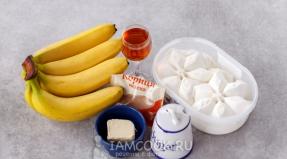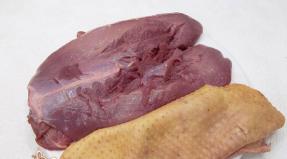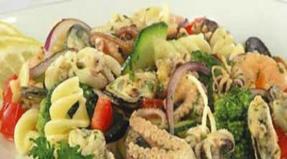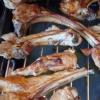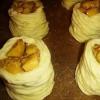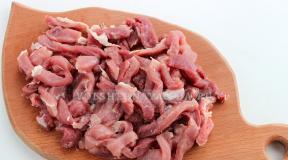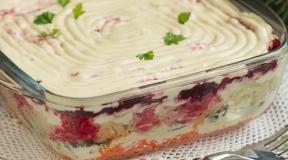How to cook dolma in grape leaves according to a step-by-step recipe with a photo. Dolma from grape leaves: a recipe for a delicious oriental dish
Cabbage rolls are popular in our national cuisine, however traditional recipes southern countries suggest the preparation of a very similar dish not from cabbage, but on the basis of young tender grape leaves. Dolma is served on the table as cold or hot appetizer, it is popular in Armenia, Georgia and Greece. Any housewife will be able to master the recipe.
How to cook dolma from grape leaves
To learn how to cook dolma from grape leaves, you need to choose the appropriate version of minced meat for the filling. Traditionally, it is made from lamb with the addition of rice and national spices, but you can try recipes based on pork or beef. In addition, it is recommended to add onions to minced meat. The specifics of further preparation depends on the characteristics national cuisine: someone cooks dolma, someone stews, and someone fries. You can serve this dish with white sauce or dressing of fried vegetables.
Grape leaves for dolma
Experienced housewives from the southern countries know that the best time for the preparation of real dolma - the beginning of June, when the greenery on the trees is just blooming, and young grape leaves still retain tender light green color. It is recommended to choose small ones (approximately the size of a woman's palm), and before cooking, lower them for two to three minutes in boiling and salted water, and then pour over ice water.
If you are interested in learning how to cook dolma from grape leaves, regardless of the season, you can learn the traditional armenian recipe, according to which the leaves should be rolled up into tubes, previously tied with threads, poured with saturated salt broth (a tablespoon of salt per glass of water) and rolled into sterilized jars. Such canned blank can be stored for a very long time.

Dolma recipe with grape leaves
Any housewife will be able to cook this dish deliciously, if you remember exactly what components minced meat includes and how much to cook dolma from grape leaves. It is difficult to immediately determine which recipe is the tastiest - it is better to try cooking according to Greek, Armenian, Azerbaijani and Georgian canons, and then choose something of your own. Gourmets are more likely to appreciate the classic homemade recipes of national cuisine.
Dolma in grape leaves in Armenian style
In order to master the Armenian version of food, it will take quite a bit of time. The recipe for dolma from grape leaves in Armenian involves the following components:
- minced fat from a mixture of beef and pork - 1 kg;
- onions - 2-3 pcs.;
- dried basil and rosemary;
- red and black peppers;
- salt;
- pickled and salted leaves.
Follow a simple algorithm:
- Mix minced meat with raw rice, spices and herbs, add a couple of tablespoons of meat broth (or clean water). Leave for 30 minutes.
- Free the leaves from the brine, dry.
- Put a couple of teaspoons of minced meat in the center of each leaf, wrap the stuffed cabbage.
- Put the rolls in ceramic pan very close to each other. Fill with water so that it covers the entire dolma.
- Put on slow fire and leave for 40 minutes. Before serving, you can add butter or white sauce yogurt.

Dolma in grape leaves azerbaijani style
It is known that Azerbaijani recipe not too different from the previous one, but lamb is preferable here - this meat corresponds to the canons of the national oriental cuisine. You will need:
- lamb (back of the leg) - 1 kg;
- tail fat - 50 g;
- rice (can be long-grain) - 100 g;
- onion- 2 pcs.;
- fresh mint;
- fresh cilantro;
- leaves;
- salt pepper.
Step by step preparation is very simple:
- Pass the lamb and onion through a meat grinder (a large nozzle would be better to use), add rice and herbs. Pour in half a glass warm water.
- Rinse the leaves from the brine, dry.
- Place a reliable plate (for example, made of tempered glass) on the bottom of the pan.
- Close the rolls. Place in a saucepan so that the cabbage rolls fit snugly together.
- Top with another plate. The dish will cook for about 40 minutes.
- While the cabbage rolls are cooking, you can make the yoghurt sauce.

Greek dolma from fresh grape leaves
The dish served in Greece will also be called dolmadakya or dolmades, a name that comes from Turkish culture and means "to wrap food one inside the other." Keep in mind that the greens must be fresh, and meat is not provided in this recipe. Dolmades is usually served among cold appetizers along with the traditional Greek sauce Tzatziki from cucumbers and yogurt. For cooking you will need:
- fresh leaves - 20-30 pieces;
- rice - 200 g;
- bulb;
- fresh herbs: cilantro, basil, mint;
- eggplant - 1 pc.;
- olive oil.
Follow step by step instructions:
- Young grape leaves should be boiled in salted water for two to three minutes in advance.
- Grate the eggplant coarse grater, coarsely chop the herbs and mix with rice and olive oil.
- Lightly simmer the filling in the pan.
- Close the doves.
- Line the bottom of the pan with torn leaves, then lay the rolls closer to each other.
- Add lemon juice, spoon olive oil, salt and spices.
- Fill with water and boil for 40 minutes.
There are a lot of dishes of different national culinary traditions which have taken root in our country. Quite popular Caucasian kitchen, for example, adjika and, of course, dolma. This delicious dish is a stuffing of meat, vegetables and rice wrapped in grape leaves. They give a light dish piquant sourness, which makes the dish taste no less interesting than cabbage rolls. We will tell you how to cook dolma from fresh grape leaves.
Dolma summerSure to cook delicious dolma, you will have to spend time and make an effort, but believe me, the result is worth it! The main thing is to properly prepare the leaves. They can be taken from both table and wine grapes, the main thing is not from the wild, they are too hard. Choose small leaves - the size of a palm, bright green, without holes and spots. We tear off the petiole so that the leaf is not damaged, you can cut it with scissors. So, dolma from fresh grape leaves, the recipe is basic.
Ingredients:
- grape leaves - 50-80 pieces;
- yellow long grain rice- 1 glass;
- veal or lamb - 0.6 kg;
- white salad onion - 2 pcs.;
- ripe not too watery dense tomatoes - 5 pcs.;
- large carrots - 1 pc.;
- parsley, cilantro, basil - 3-4 branches each;
- freshly ground pepper (mixture) - ¼ teaspoon;
- ordinary rock salt - 1 teaspoon;
- vegetable oil, which does not have a pronounced odor - 50 ml.
Cooking
First you need to make the filling. Wash the meat and dry it with a napkin, pass through a meat grinder with a large nozzle. Please note - the meat should not be completely fat-free, otherwise the dolma will turn out dry and tasteless. Therefore, it is good to include a little chicken fat in the minced meat if the piece of veal is completely lean. We clean the onions and carrots, cut into small cubes and simmer in hot oil in a cauldron or in a frying pan until soft - that is, about 10-12 minutes. In the meantime, sort and rinse warm water rice, wash the tomatoes and grate them or puree them (use a blender, food processor, chopper, meat grinder). Adding tomato puree to vegetables, salt, pepper, simmer for another 3 minutes. Mix the filling: meat, rice, roast. Add finely chopped herbs and stir. While the filling is cooling, we are engaged in leaves. They need to be folded into a basin, poured cold water and wait about a quarter of an hour, rinse the leaves and change the water - now pour the leaves with boiling water. We wait 7 minutes and take them out carefully. The leaves become darker in color, much more elastic, but they also tear more easily, so we work with them carefully. Put some filling on the edge of each leaf and fold it into an envelope. We cook dolma in a saucepan or cauldron - we line the bottom with leaves, we put envelopes tightly on them. Pour them with lightly salted boiling water and cook for about 10 minutes after boiling. We serve dolma with sauces: garlic, tomato or simply with sour cream - it is also very tasty.
Dolma spicyAzerbaijani dolma is more interesting in taste: the recipe includes spices, Pine nuts, but do not put vegetables.
Ingredients:
- rice not steamed - 120-150 g;
- lamb of medium fat content - 0.5 kg;
- round white onion - 2 pcs.;
- leaves, steamed grape - 400 g;
- vegetable oil refined - 30-40 ml;
- dried herbs (mint, savory, oregano, basil) - 1 tbsp. spoon with a slide;
- parsley - 1 small bunch;
- peeled - 1 handful;
- garlic - 4 medium cloves;
- iodized salt - 1 teaspoon;
- freshly squeezed lemon juice - 50 ml;
- freshly ground pepper (mixture) - at the tip of a spoon;
- meat broth - about 1 liter.
Cooking
We wash the rice, prepare minced lamb, clean and fry finely chopped onions in vegetable oil until brownish. In a bowl, put the roast, minced meat, rice, chopped garlic (can be grated), nuts roasted in a dry frying pan, salt, pepper, pour lemon juice, seasoned with dry herbs and chopped parsley. We mix. We wrap the filling from the edge where the petiole was.  Carefully form envelopes. Dolma is cooked from fresh grape leaves in a cauldron, saucepan or slow cooker - pour broth and wait.
Carefully form envelopes. Dolma is cooked from fresh grape leaves in a cauldron, saucepan or slow cooker - pour broth and wait.
Many are interested in how to keep fresh grape leaves for dolma for the winter. Cooking empty plastic bottles. We use only dark plastic. Rinse and dry them thoroughly. Then we roll the dry leaves of 10 pieces into a tube, lower them into bottles, tightly twist the lids and store in the basement. You can use the leaves until the summer - they remain fresh and fragrant. Just cut the bottle and remove the leaves for dolma.
I walked around the market and noticed grape leaves for sale. I decided that I can pamper my loved ones and relatives with dolma. These are the so-called small cabbage rolls in grape leaves, the progenitors of the well-known cabbage rolls in cabbage leaves. Taste the dolma and then compare it with the recipe for delicious cabbage rolls. Like cabbage rolls, dolma can be stored in the freezer as a semi-finished product for several months. Therefore, you can always prepare another batch for the future.
Dolma is a wonderful oriental dish that will be an excellent decoration for both festive and everyday table. And what can we say about the usefulness of this delicious dish! Grape leaves contain a lot dietary fiber that improve digestion and stimulate metabolic processes in organism. Frequent use grape leaves improves vision, potency and slows down the aging process. Perhaps that is why dolma is so valued among Eastern centenarians.
Dolma has many various options cooking, but I will tell the recipe as close as possible to the traditional.
Ingredients:
- 50 pieces of salted grape leaves (you can use fresh);
- 500 ml of water or meat broth for cooking dolma;
For filling:
- 0.5 kg of minced meat (lamb + beef or pork + beef);
- 0.5 st. rice
- 2 large onions;
- a small amount of vegetable oil for frying;
- small bunches of greens: mint, basil, parsley;
- zira — a pinch;
- salt;
- ground black pepper;

Recipe for a delicious classic dolma
1. Rice must be thoroughly washed 5-6 times until the water becomes clear. Next, pour our rice with boiling water so that the water slightly covers it and leave to swell. This way, the rice absorbs water and won't take away the juice from the minced meat, which will make the dish more juicy.
Or, you can boil rice until half cooked. To do this, rinse the rice well, add water, bring the water to a boil and boil for about a minute over medium heat.

2. Cut the onion very finely and set the pan to heat up.

3. Add vegetable oil to a preheated pan and spread the onion. Saute the onion, stirring evenly, until translucent.

4. When the onion has become transparent, pour our slightly swollen rice into the pan. Stir evenly so that the rice absorbs the onion juice. After that, the filling for dolma will become even tastier. Remove the pan from the heat and leave to cool.

5. Cut the parsley very finely and put it in a deep bowl, in which we will prepare the stuffing for minced dolma.

6. Add minced meat to parsley.

7. Add spices, salt and pepper. We mix.

8. Put the onion with rice to the minced meat. Mix thoroughly again.

9. While the minced meat is infused, we will prepare the grape leaves. For dolma, you need to use young green leaves, and they should be collected in the spring. Such leaves are preserved for a year in advance in lightly salted water. Jars of blanks can be found on the market with pickles from private traders.
Carefully straighten the finished grape leaves and remove the petioles. We sort through each sheet, putting aside the damaged ones. We will also need them, but not for wrapping dolma, but for a substrate in cauldrons.
If you use fresh young leaves, then before cooking they need to be poured with boiling water and held in this form for about 10 minutes.

10. We lay out the grape leaves with the smooth side down, the veins should be directed upwards.

11. Spread a little stuffing closer to the middle of the sheet.

12. Close the filling with the bottom edge of the leaf.


14. We roll up our first dolma with a tight tube.

15. We fold the rest of the dolma using the same technology.

16. We lay part of the prepared grape leaves on the bottom of the cauldron in 1-2 layers.


18. We cover the dolma laid in a cauldron with the remaining grape leaves.

19. Pour meat broth or water so that the liquid slightly covers the dolma. We put a plate on top, and, if necessary, put a load on top. The latter is necessary so that the dolma does not turn around during cooking.

20. Put the cauldron on the fire and bring to a boil. When the water boils, reduce the heat to a minimum and continue to cook for 1-1.5 hours on a slightly noticeable boil. Then remove the cauldron from the fire and leave for 10-20 minutes to brew.
The most delicious dolma ready. Serve with sour cream or sour cream and garlic sauce. Bon Appetit!

There are dishes that are more successful for a woman, but there are purely masculine joys of gastronomic life, where men have no equal! Yes, we are talking about winemaking, because only a gambling man can produce Home wine from grapes, the recipe of which becomes his pride! A woman here can only be “on the hook” - to prepare the container, and to cheer up the man and praise him for his skills and enthusiasm!
We will share with you classical technology making homemade wine from grapes, the recipe of which will allow even a novice winemaker to be proud of the result. So let's get started!
Terms
Mezga is the initial, intermediate product of winemaking technology. It is a mass of crushed grapes, with or without ridges. The stems must be taken away, otherwise the wine may be bitter.
Wort- this is not clarified grape juice that stands out from the pulp. This is, in fact, a young wine that has not yet begun to ferment.
Fermentation- process of reproduction wine yeast, which fruit sugar in berries they are processed into alcohol, and as a result we get wine!

What is the best grape variety
For home production grape wine technical (wine) grape varieties should be used. The clusters of these varieties are small in size, the berries are small and close to each other.
These are varieties such as Merlot, Isabella, Cabernet, Muscat, Sauvignon, Dove, Chardonnay, Riesling and others.
Preparatory work
Harvested or bought grapes should not be washed, because wine yeast lives in abundance on the surface of the berries. The grape harvest, harvested after heavy rainfall, is not suitable for the production of natural wines for the same reason. And do not be afraid of dust on the surface of the clusters either - it will settle, and in the process of fermentation the juice will self-purify.
Clusters must certainly be freed from atmospheric moisture and be dry - this important condition quality homemade grape wine, the recipe of which we are studying. However, this applies to any of the recipes for making wines at home!
We separate the berries from the ridges, selecting moldy, dry and spoiled - they can spoil the taste of the drink. Now we need to transfer the raw materials to the state of pulp, and it is more convenient to do this in parts, if we crush the grapes with an ordinary potato masher.
You need to knead diligently so that each berry gives all the juice.

If winemaking promises to become your hobby, then it is justified to purchase a special crusher. For a small amount of wine material, you can also use a meat grinder.
grape homemade wine recipe
Stage I
The resulting mass of pulp is poured into a large prepared container - a wooden or polyethylene barrel, or enamel pan, given that it only needs to be filled 2/3. We cover the container with a cotton cloth and fasten it around the circumference of the dish.
Temperature conditions for fermentation: 18-23°C. If the temperature is higher, the quality of the final product will suffer, or even vinegar fermentation will begin, which will turn the wort into vinegar.
Temperatures below 18 ° C will slow down the fermentation process, which may not even begin at this temperature.
Experienced winemakers advise: if you brought grapes from fresh air with a temperature of 10-15°C, then bunches of grapes should warm up to room temperature.
You can not even begin to crush them until they gain heat.

Set aside the container grape pulp at rest for 3-5 days. The very next day, the rapid growth of yeast bacteria begins, accompanied by fermentation.
The must begins to actively separate, and the pulp begins to collect on the surface liquid mass aided by the active release of carbon dioxide. This risen pulp must be mixed with the must more than once a day, otherwise the pulp will peroxide and spoil the future wine.
Many winemakers use only freshly squeezed juice to make homemade grape wine, and discard the skins and seeds. But, in order to obtain an aromatic drink with a beautiful rich color, professional winemakers will never refuse the pulp, which gives the wine a noble aftertaste!

Stage II
After the prescribed 3-5 days, squeeze the pulp - first through a colander, then through several layers of unbleached gauze. Now, for subsequent fermentation, the wort is poured into a volumetric glass container by three quarters of the volume and tightly closed with a cork with a straw.
If we leave the pulp, then we skip the previous step.
This tube to remove carbon dioxide is called a water lock, which protects the wort from oxygen and souring. We lower the tube with one end into the wine, the other into liter jar or a glass of water.
At the same stage, we also regulate the strength of homemade wine from grapes. It depends on the amount of fructose in the berry and the amount of sugar that should be added during the fermentation process. Grape varieties grown in our countries do not contain fructose above 20%, and therefore the missing sugar must be added. Otherwise, we will get dry sour wine.
Add sugar dosed: 200-250 g of sugar per 1 liter of wort. To do this, you need to pour a little juice, heat it and dissolve sugar in it, and then pour it into a common container and securely close it with a cork.

In general, grape must without pulp ferments for approximately 21-30 days at room temperature. During fermentation, the yeast settles to the bottom, the wine clarifies and gradually acquires density, and the release of carbon dioxide stops.
Stage III
We separate the sediment from the clarified must: by draining (through a tube, lowering the second container below the container with wine). If it didn’t work out carefully, then we filter the wine through several more layers of gauze.
Checking the sweetness if you love dry wine no need to add sugar. If you like sweet wine more, then add sugar, remembering to mix it in wine until completely dissolved.
Pour into prepared glass containers dark in color and loosely stoppered so that the carbon dioxide still escaping finds its way out.

Stage IV Stage V
This stage of winemaking at home is different, because. every artist has his own opinion. We are talking about the sterilization of unripe grape wine.
Some winemakers believe that wine should mature naturally a few months, and he should not be disturbed. For natural maturation, it is necessary to install water locks for each bottle and place it in a cool and dark place until the complete cessation of fermentation of wine from grapes.
A minimum of 2-3 months is usually spent on maturation, during which the wine is drained several times from the resulting sediment.

Another part of winemakers insists on sterilization of bottles with wine material and its further maturation in tightly sealed dark glass containers.
How to do it, according to this recipe?
- Pour the wine into bottles, cork loosely, wrap it with any cloth and place it in a tank with water (it should reach the bottle hangers).
- We lower the thermometer into one of the bottles and sterilize until the temperature of the wine in the bottle rises to 60 degrees. This completes the sterilization process.
During the sterilization process, wine yeast is completely killed, thereby further fermentation becomes impossible. At the same time, the bottles in the water are closed with corks loosely - to release carbon dioxide.
At the end of sterilization, the bottles are tightly corked. Leave to cool in conditions room temperature and then take it to a cool place for storage.

The wine material that has passed sterilization is excellently brightened, matures qualitatively, and the wine is distinguished by a velvety softness of taste, with a magnificent aftertaste. Drink of the gods! But even after sterilization, it needs to be “drained from the sediment” several times.
Wine with the addition of water and wine yeast (video)
You can store homemade wine from grapes, the recipes of which we have examined in detail, for up to 10 years, at a temperature of 10-15 degrees.
Not all housewives know how to cook dolma at home. She seems pretty complex dish, although in reality you will need little: rice, some minced meat, leaves, special spices and a special sauce. In this article you will find a selection best recipes and learn the tricks of cooking dolma from different peoples peace.
Classic grape leaf dolma
In the Caucasus, not a single solemn feast can do without dolma from grape or fresh leaves. Are they waiting dear guest, celebrate a wedding, celebrate a birthday - the hostess spins a whole pan of fragrant "tubes" with meat filling. Dolma is delicious hot and even cold, and it seems that it is absolutely impossible to get enough of it! Especially if you dip it in a spicy white sauce, eating warm pita bread.
The right to invent dolma is disputed by Armenia, Azerbaijan and even Uzbekistan. But varieties of dolma (or, as it is called in another way, tolma) are also found in Turkey and the Balkan countries. Culinary historians suggest that the dish was “inherited” from the Ottoman Empire, where it was constantly prepared at receptions for entire palaces. It is clear that since the time of Sultan Suleiman, the recipe has gone through a lot of changes. But the essence has not changed.
To prepare classic dolma, we need:
- a kilogram of minced meat (any, but not chicken!);
- grape leaves (it is difficult to guess the number, it all depends on the number of eaters, at least 50 pieces);
- large onion;
- egg;
- a handful of white rice;
- a large bunch of greens - parsley, dill, and (this is a must!) cilantro;
- salt and pepper to taste.
First of all, boil the rice until half cooked and mix it with minced meat. We cut the onion, greens into small cubes, add one chicken a raw egg, salt and pepper to taste. We knead the minced meat so that it turns out to be dense, uniform, well away from the hands.
Pour boiling water over fresh grape leaves, and then let them cool. It remains to masterfully twist the dolminki. To do this, put on a sheet (on the rough side) meat stuffing and pack, bending the edges to the center.
Ready-made dolminkas resemble tubes or cigars - whoever likes what association. We lay them on the bottom of a large pan, pressing tightly to each other. It remains to pour meat broth or water (to the height of one thumb), press everything with a plate of a slightly smaller diameter, let the water boil and simmer until the leaves and minced meat are ready. The total cooking time from the moment of boiling is 40-60 minutes.
We serve the finished dolma for big platter, and next we put a white sauce of yogurt, garlic and herbs. We put large bunches of greens, warm pita bread on the table, and watch how our dolma is eaten in a matter of minutes!
In a slow cooker
A slow cooker makes life easier for any housewife, significantly reducing cooking time. Dolma is no exception. Prepare dolma according to any recipe, put it in dense layers on the bottom of the multibowl, fill it with water, start the “cooking” mode.



Why press the dolma? So our dolminki will not fall apart during cooking, and it will not be necessary to remove the foam from the broth.
If you don’t want the leaves to “untie” in the process, and the dolma to lose its shape, do it simply - cook it with the lid open, laying a light oppression plate on top with a diameter slightly smaller than the bowl. Usually, it takes 30 minutes to cook in a slow cooker, and, which is nice, you can safely get down to business - the smart device itself will notify you when the cooking process is over.
Cooking according to the Azerbaijani recipe
Remember the legendary dialogue from the movie "Mimino" between an Armenian and an Azerbaijani. “Do you like dolma? No. It's because you don't know how to cook it." For hundreds of years, these two countries have been contesting the right to call dolma their own. national dish. It is curious that the Ministry of Culture of Azerbaijan has already applied to UNESCO with a request to recognize dolma as an intangible heritage of the country. In the meantime, UNESCO is making decisions, let's learn the tricks of preparing branded Azerbaijani dolma.

The ideal size of the leaves is the palm of a young woman, and the “fingers” of the dolma should be small and neat. Big dolma is a sign of a lazy craftswoman.
Cooking in this way:
- For signature recipe you will need a kilogram of veal, rice and tender grape castings. They should be thin, young, and even better, plucked from a tree in own juice. In winter, dolma from pickled grape leaves will go with a bang, but still its taste will be completely different. In Azerbaijan, fresh leaves are preferred to pickled ones.
- We scroll the veal with fat tail fat through a meat grinder, add onion, herbs there, pour warm boiled water(approximately a glass). The consistency should be slightly liquid, otherwise, the Azerbaijanis are sure, the dolma comes out dry.
- Pour the minced meat with half a glass of round rice.
- We twist the dolma, as in the classic recipe, forming neat “fingers”.
- We put them in a pan in dense layers.
- Fill with water.
- We press with a plate.
- Let the saucepan boil.
- We bring it to readiness in about an hour.
- Turn off, let cool.
- Lay out on a flat dish.
Serving dolma with sauce natural yogurt with garlic (you can add a bunch of any chopped greens there), invite guests and enjoy!
Dolma in Armenian - step by step
Classic dolma with grape leaves in Armenia is always prepared with three types of meat - beef, pork and lamb, which are mixed in equal amounts.



Cilantro, basil, parsley and dill are always put in the Armenian dolma. other spices - at the discretion of the hostess.
The recipe looks like this:
- 500 g of beef, pork and beef are scrolled through a meat grinder.
- Add finely chopped onion.
- We cut a bunch of greens.
- We add salt.
- Add black pepper.
- Rice is washed and poured into minced meat. The amount of rice should be 2-3 times less meat. You need to understand that in the process of cooking it will boil.
- Stir the mince thoroughly.
- Pour boiling water over fresh grape leaves. In winter, pickled, salted leaves, thoroughly washed from salt, are used in Armenia. Fresh ones are also preferred in summer.
- Flip the leaves upside down.
- Put a little minced meat in the middle of each (about one and a half teaspoons).
- From the leaves we form dolmushki, resembling thin cigars. You should not twist them tightly, because the rice should boil.
- Line the bottom of a large saucepan with large grape leaves.
- From above we distribute the dolminki, firmly pressing them to each other.
- Fill the dolma with water a couple of centimeters above the tubes - it should cover our grape "cigars" by about a thumb.
- Place a small lid on top.
Let the water boil, and then reduce the fire to a minimum and simmer until the grape leaf is soft for 40-50 minutes. While dolma is cooking, cook delicious sauce from yogurt, garlic and herbs. Modern recipe sauce allows you to use ready-made mayonnaise (high-quality!), Mixed with fresh sour cream, as a base. But yogurt or yogurt, of course, remain a priority.
Interestingly, in Armenia, any stuffed vegetables are called dolma. Zucchini, eggplant, tomatoes, quince, small cabbage rolls are stuffed with minced meat, in a word, all vegetables that can be stuffed with meat and stewed. The "chip" of the dish is that only the freshest and most fragrant fruits are used. By big holidays prepare royal dolma: in one large saucepan stew several types stuffed vegetables simultaneously. They give each other flavors and turn out delicious!
With lamb and mint
In the Caucasus, there are families who cook dolma exclusively from lamb, and as a seasoning they always add mint leaves, without stems. Mint and lamb go together amazingly! Such dolma is spicy, tender and very fragrant. The main thing is not to overdo it with mint, because, as an active spice, it can kill the taste of lamb.

Dolma will become even tastier the next day, when grape leaves and meat juices share flavors with each other.
For cooking, you can take any recipe you like above. We twist the lamb through a meat grinder, add onion, herbs, a bunch of mint leaves, season with salt, pepper and pour in a little rice. We knead the minced meat and sculpt the dolminki. Cook according to instructions classic recipe pressing with a light pressure.
Serve with white sauce, warm tortillas and fragrant tea with herbs.
With matsoni sauce
Dolma from a semi-finished product - very convenient preparation for any celebration. It is quite possible to make it a few days before the proposed holiday, freeze in the refrigerator and cook without defrosting. The taste will not be lost. A favorite will help emphasize the dish fermented milk product all mountain peoples - matsoni.



Matsoni is a kind of curdled milk, but slightly less acidic. It is thick in itself and it is enough just to salt it, add garlic and herbs to make the taste rich. This white sauce is also low in calories, so eat it without fear of extra pounds.
Dolma seems like a troublesome dish. But only at first sight. In the Caucasus, it is spun by whole families, like dumplings in Russia, and the cooking process turns into interesting event. Dolma is prepared with joy, they drink young wine, and then they all eat it together, enjoying the taste of dolma and communication. Try to cook dolma - discover a new hobby and a great companion dish.
